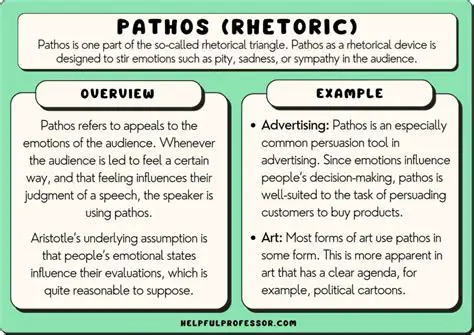Rhetorical Analysis: A Pathos-Driven Call to Action

In the realm of persuasion, emotions hold immense power. Rhetorical analysis examines how language evokes feelings to shape opinions and influence behavior. This article presents a comprehensive rhetorical analysis example, exploring how a persuasive text effectively employs pathos to rally its audience.
Understanding Pathos: The Emotional Appeal
Pathos, one of the three pillars of rhetoric (along with logos and ethos), appeals to the emotions of the audience. By eliciting feelings such as fear, empathy, and hope, speakers or writers can create a powerful connection and motivate their audience to take action.
Rhetorical Analysis Example: A Passionate Plea for Change
Consider the following excerpt from a speech by Dr. Martin Luther King Jr., delivered at the Lincoln Memorial during the March on Washington in 1963:
“I have a dream that my four little children will one day live in a nation where they will not be judged by the color of their skin, but by the content of their character.”
Analysis: How King Employed Pathos
1. Vivid Imagery and Emotional Language
King’s dream of a colorblind society is painted with vivid imagery. The words “nation” and “content of their character” evoke a sense of belonging, fairness, and equality. The repetition of “I have a dream” creates a rhythm that stirs emotions.
2. Personal Storytelling
King shares his personal aspirations for his children, humanizing the issue and making it relatable to the audience. The audience empathizes with his hopes and fears, making them more invested in his message.
3. Contrast and Juxtaposition
King contrasts his dream of a just society with the harsh realities of racial discrimination at the time. This juxtaposition heightens the emotional impact, creating a sense of urgency and inspiring the audience to demand change.
Key Takeaways for Effective Pathos Appeals
The rhetorical analysis example demonstrates how effective pathos appeals can be crafted:
Strategies:
- Use vivid imagery and emotionally charged language.
- Share personal stories to foster empathy.
- Contrast positive visions with negative realities to create a sense of urgency.
- Utilize repetition and rhythm to create an emotional impact.
Common Mistakes to Avoid
Mistakes:
- Using manipulative tactics that exploit emotions without substance.
- Relying solely on pathos without providing logical arguments or establishing credibility.
- Overusing emotional language that can become repetitive or overwhelming.
Applications in Various Contexts
The principles of rhetorical analysis can be applied to a wide range of persuasive contexts, including:
| Context | Example |
|—|—|—|
| Political speeches | Mobilizing voters through emotional appeals |
| Advertisements | Creating a desire or sense of urgency |
| Non-profit fundraising | Evoking empathy to encourage donations |
| Educational presentations | Engaging students by connecting with their emotions |
Tables for Further Analysis
Table 1: King’s Use of Emotional Appeals
| Appeal | Example | Effect |
|---|---|---|
| Fear | “I have seen the evils of segregation and discrimination.” | Inspires urgency and motivates action. |
| Empathy | “I have a dream that my four little children…” | Fosters connection and generates sympathy. |
| Hope | “We will overcome this.” | Inspires optimism and empowers the audience. |
Table 2: Strategies for Effective Pathos Appeals
| Strategy | Explanation |
|—|—|—|
| Anecdotes and personal narratives | Use personal stories to connect with the audience on an emotional level. |
| Figurative language | Employ metaphors, similes, and other forms of figurative language to create vivid imagery and evoke emotions. |
| Emotional appeals to human nature | Tap into universal human emotions such as love, fear, and compassion. |
| Rhetorical questions | Engage the audience and prompt them to reflect on their own emotions. |
Table 3: Common Mistakes in Pathos Appeals
| Mistake | Explanation |
|—|—|—|
| Overreliance on emotional manipulation | Using pathos without providing logical arguments or establishing credibility. |
| Excessive sentimentality | Overusing emotional language that can become overwhelming and lose its impact. |
| Failing to connect with the audience | Using emotional appeals that are not relevant or relatable to the listeners. |
Table 4: Applications of Rhetorical Analysis in Persuasive Contexts
| Context | Applications |
|—|—|—|
| Political speeches | Analyzing how politicians use pathos to mobilize voters and win elections. |
| Advertisements | Examining how advertisers evoke emotions to influence consumer behavior. |
| Non-profit fundraising | Exploring how charities use emotional appeals to secure donations and support their causes. |
| Educational presentations | Evaluating how teachers employ pathos to engage students and make learning more memorable. |
Conclusion
Rhetorical analysis is an essential tool for understanding how persuade. By analyzing how speakers or writers appeal to emotions, we can identify effective strategies and avoid common pitfalls. The example provided in this article demonstrates the power of pathos in shaping opinions and inspiring action. By incorporating the principles of effective pathos appeals into persuasive communication, we can craft messages that resonate with audiences, move them emotionally, and achieve desired outcomes.
